According to the Monster Work Watch Report, 64% of employers plan to continue hiring in 2024 and further, with only 2% expecting layoffs.
On the other hand, employees are actively seeking better opportunities, with 95% looking or planning to look for a new job.
This indicates a strong demand for job search platforms. Indeed, for instance, is projected to be the most popular career search destination for job seekers in the next few years.
So, in this guide, we’ll explore the secrets behind the success of top job search platforms like Indeed, Glassdoor, and LinkedIn. Additionally, we’ll discuss best practices for developing such a platform.
What is an online job board website?
A job search website is an online platform designed to connect job seekers with potential employers. It serves as a digital marketplace where employers post job openings and job seekers search and apply for these opportunities.
These websites offer a range of features and services to facilitate the job search and recruitment process for both parties. Key reasons for the popularity of job search platforms include:
- Convenience. Users can search and apply for jobs anytime, anywhere, using their computer or mobile device;
- Efficiency. Search filters help job seekers quickly find relevant job openings, while employers can efficiently manage and review applications;
- Access to opportunities. Job seekers gain access to a wide range of listings across various industries and locations. Employers, on the other hand, can reach a large and diverse candidate pool, including both active job seekers and passive candidates open to new opportunities;
- Networking. Platforms like LinkedIn offer networking opportunities, enabling users to connect with industry professionals and potential employers;
- Resources and tools. Many job search websites provide additional tools and resources to aid in the job search process and career development, as well as streamline the recruitment process.
Partner with experts in custom software development!
Check out our featured projects to discover the full scope of our capabilities.
See casesWhat makes a successful job search website?
Indeed.com, Glassdoor.com, and LinkedIn.com are the leading platforms for job search and recruitment in 2024. Let’s analyze the reasons behind their success:
- Indeed gained prominence by being the first job posting aggregator. While other platforms only allowed job postings directly on their sites, Indeed also collected postings from various websites and displayed them. This resulted in Indeed having the most extensive collection of job postings, attracting job seekers who chose it as their primary platform to post resumes;
- Glassdoor is often considered the second most popular job search website in the USA. Its popularity is mainly due to its role as a crucial resource for learning about a company’s internal culture, industry salary averages, and more;
- LinkedIn has seen a significant rise in popularity as an effective tool for job search and recruitment in recent years. It allows users to leverage their network and word-of-mouth referrals to find jobs or hire valuable talent.
As you can see, while all these job search websites aim to connect recruiters and candidates, they each have unique approaches that attract their loyal users. Now, let’s discuss how to build a job search website.
How to create a job board website from scratch?
1. Choose your niche
The one-stop-shop approach works well for giants like Indeed but is challenging for new platforms. Instead, focusing on a specific niche offers less competition and makes it easier to develop a unique offering that stands out.
Targeting a niche audience also increases the likelihood of providing relevant results, building trust, and gaining a loyal user base.
To identify a suitable niche for your job search website, consider these steps:
- Reflect on your background, knowledge, and interests: If you have experience in healthcare, for example, consider starting a job board website for healthcare professionals. A niche where you have expertise or passion will be easier to manage and market;
- Research the market: Use tools like Google Trends, Keyword Planner, and industry reports to analyze search volumes and trends in various job sectors. Look for niches with demand but less competition;
- Evaluate market trends: Currently, the tech industry and cybersecurity roles face talent shortages, indicating a need for specialized job boards in these areas;
- Assess competition: Analyze existing job board websites in potential niches to see what works and identify areas for improvement. Note aspects that you can enhance in your platform.
Examples of successful niche job search websites include Behance, targeting creative professionals; LawCrossing, focused on legal staff; FlexJobs, offering remote jobs exclusively; and Fuzu, connecting employers and job seekers in Africa.
In fact, Fuzu initially targeted a few African countries and received a significant growth boost after its website was revamped by Syndicode.
2. Determine your target audience
The better you know your users, the better you can tailor your website’s functionality to their needs and preferences, enhancing job matching, giving you better competitive positioning, and enabling you to use resources for marketing more efficiently.
Here’s some advice on how to effectively identify your target audience:
- Use market research findings from the previous step to learn about trends and determine roles with the highest demand;
- Identify popular keywords used to search for jobs in your selected niche;
- Understand the specific challenges faced by potential users by conducting surveys, interviews, and focus groups;
- Divide the target audience into distinct segments for tailored marketing and development strategies;
- Create detailed user personas representing different segments of the target audience.
Here’s an example of the process of determining the target audience for a remote job search platform:
| Step | Objective | Actions | Findings |
|---|---|---|---|
| Market research | Understand the landscape of remote tech jobs and identify potential demand | Analyze industry reports about remote work trends and tech industry growth; Keyword analysis | High demand for remote tech roles such as software developers, data scientists, and cybersecurity experts; Increasing trend towards remote work due to flexibility and global talent access |
| Pain point identification | Understand the specific challenges faced by remote tech job seekers and employers | Surveys and interviews with tech professionals and HR managers; Focus groups with tech job seekers | Job seekers need reliable platforms with verified remote job listings; Employers struggle to find qualified remote candidates and assess their skills remotely; Both parties value features like virtual interview tools and project-based assessments |
| Market segmentation | Divide the target audience into distinct segments | Segmentation criteria: job role and experience level | Entry-level remote tech professionals; Mid-level to senior remote tech experts; Tech startups and SMEs looking for remote talent |
| Define user personas | Create detailed user personas representing different segments of the target audience | Data compilation from market research, surveys, and interviews | 1. Junior Developer (Job Seeker) 2. Experienced Data Scientist (Job Seeker) 3. Tech Startup Recruiter (Employer) |
3. Identify competitors
Studying successful competitors in your niche can provide insights into effective strategies and best practices. By analyzing feedback your competitors have received, you can identify unmet needs and gaps in their services, helping you better position your own job search website.
To identify both direct and indirect competitors, consider the following steps:
- Search online using relevant keywords and identify top-ranking websites that appear in search results;
- Review industry reports, market analyses, and trade publications to determine key players in the job search market;
- Visit job site aggregators to see which specialized job boards rank high;
- Monitor social media and online communities like LinkedIn groups, Reddit, and Quora to find out which job search websites are frequently mentioned and recommended by users.
Once you’ve identified the top players, visit their websites and note their features and user interface. It’s also a good idea to check review sites like G2, Trustpilot, and Glassdoor for user reviews and ratings of job search websites. This will help you understand user satisfaction levels and common complaints.
Don’t forget to use market research tools like SimilarWeb, Ahrefs, and SEMrush to analyze traffic, user engagement, and referral sources on popular job search sites. This analysis will provide a benchmark for your website and help identify the most effective channels that drive traffic.
4. Choose a business model
The choice of a suitable business model is a significant part of answering the question, “How to build a job search website?”
So, how do job boards make money? Let’s find out.
Job posting
This revenue model involves charging employers for publishing their job offerings on your platform. For example, Dice charges $495 for a single post that will be displayed for 30 days.
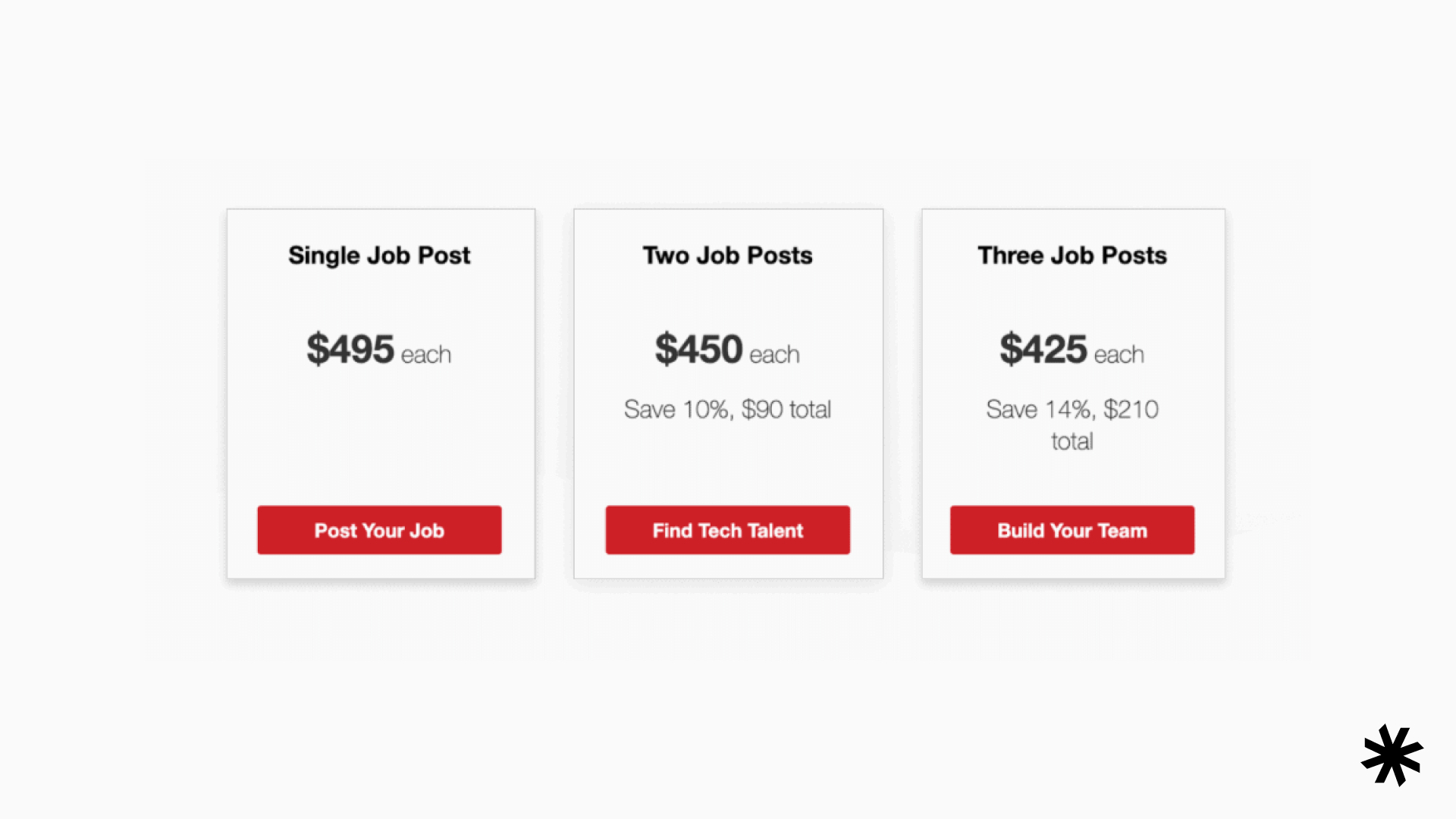
Pay per click (or lead)
You can allow companies to post their vacancies for free and charge them when a potential employee shows some interest in the vacancy.
Subscription
By paying a monthly fee, employers can publish an unlimited number of job offerings.
Different plans and packages
Offer different packages that vary based on the included functionality. By providing several options, you give users the flexibility to choose the solution best suited to their budget and business goals. Below are the packages offered by the job board website Fuzu:
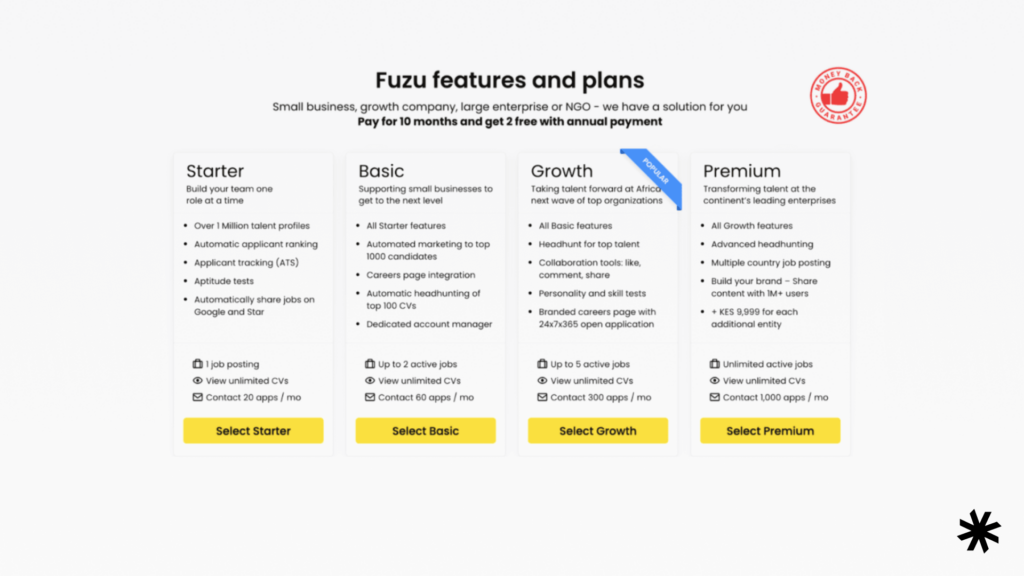
Sponsored job post
If employers need better visibility for their vacancy posts, you can highlight their job offering for an additional fee. You can also charge them for promoting their vacancy on social media or partner websites.
Career or recruitment services fees
If you wonder how to create a job search website that stands out from competitors, consider offering additional services at an extra cost. These can include writing CVs, providing training to increase the chances of successfully passing an interview, or offering recruitment services such as candidate sourcing, screening, and headhunting for a fee.
CV access fee
Finally, you can charge employers for access to job seekers’ CVs. This business model can be very profitable if there are a large number of applicants on your job board website.
| Monetization model | Advantages | Best for |
|---|---|---|
| Paid job postings | Direct revenue from each job posting; Simple and straightforward; Can be scaled with different pricing tiers | Platforms with a large user base and high traffic; Job boards where employers are willing to pay for visibility |
| Subscription plans | Financial stability; Attracts serious users who are willing to invest in their job search or recruitment process | Niche job boards with specialized features; Platforms offering additional services like advanced search filters, analytics, or enhanced profiles |
| Pay-per-click (PPC) advertising | Attracts employers who prefer to pay for actual engagement rather than just posting | Platforms with high traffic and engagement; Sites with sophisticated tracking and reporting systems to ensure transparency |
| Advertising and sponsored content | Additional revenue stream without charging users directly; Can be combined with other monetization models | Platforms with high traffic and a broad user base that attract advertisers |
| Career/recruitment services | High revenue potential; Builds strong relationships with users through personalized services | Niche job boards with expertise in a specific industry; Platforms with a strong network of qualified candidates |
| CV access fee | Recurring revenue; Can be combined with other monetization models | Niche job boards; High-traffic platforms; Recruitment agencies |
5. Find your Unique Value Proposition (UVP)
Let’s be real: there are many job search platforms out there. To maximize your chances of getting the attention you need, your platform must clearly and concisely state its value and benefits compared to competitors.
Additionally, having a formulated and written UVP will help guide future business decisions. It will prevent you from deviating too much from the website’s original mission and losing focus.
Here’s some advice:
- Gain deep insights into what your audience values most in a job search platform using market research;
- Identify what differentiates your platform from existing options through competitor research;
- Create a feature inventory by listing the unique features and services your platform offers;
- Map the benefits of each feature by connecting them to specific advantages for users (e.g., faster hiring process, better job matches, enhanced user experience);
- Write the UVP, ensuring it specifies your target audience, the specific problem your platform solves, the unique solution, and the key benefits users gain from using your platform.
A UVP is usually displayed prominently on the website homepage to attract user attention and is incorporated into marketing materials.
Got an idea?
Let our experts bring it to life! Share your vision and requirements with us, and we’ll return with a proposal just for you.
Get in Touch6. Choose core features
Ideally, you would launch a comprehensive product offering the widest range of job search and recruitment services along with impeccable UX.
In reality, however, various factors limit you. One major concern is that a lengthy development process increases the risk of your solution becoming obsolete before it even reaches the market.
Therefore, it’s useful to determine how to build a job search website that provides significant value for users while taking the minimum possible resources to create.
Here are some tips to make your job simpler:
- Define primary business goals (e.g., user acquisition, engagement, revenue generation);
- Prioritize features by categorizing them based on importance and impact concerning both business goals and user needs and pain points;
- Create a prototype to visualize the job search website with the core features. Gather initial feedback from stakeholders and possibly a focus group;
- Iterate and improve until you’re confident that all the features on your list are valuable and feasible and that you haven’t missed anything.
Below are some considerations for features present in all popular job search platforms.
Features for job seekers
Personal profile
To enable job matching, a job search platform needs access to a candidate’s skills, experience, education, and career aspirations.
Additionally, this feature speeds up and simplifies the application process for job seekers, as they only need to fill in the information once and can reuse it for multiple applications.
Vacancy search and filters
Search and filter features on a job search website allow users to quickly find job listings that match their specific criteria.
For example, the job search platform Fuzu, created by our team, allows job seekers to filter results by publishing date, profession, industry, and seniority.
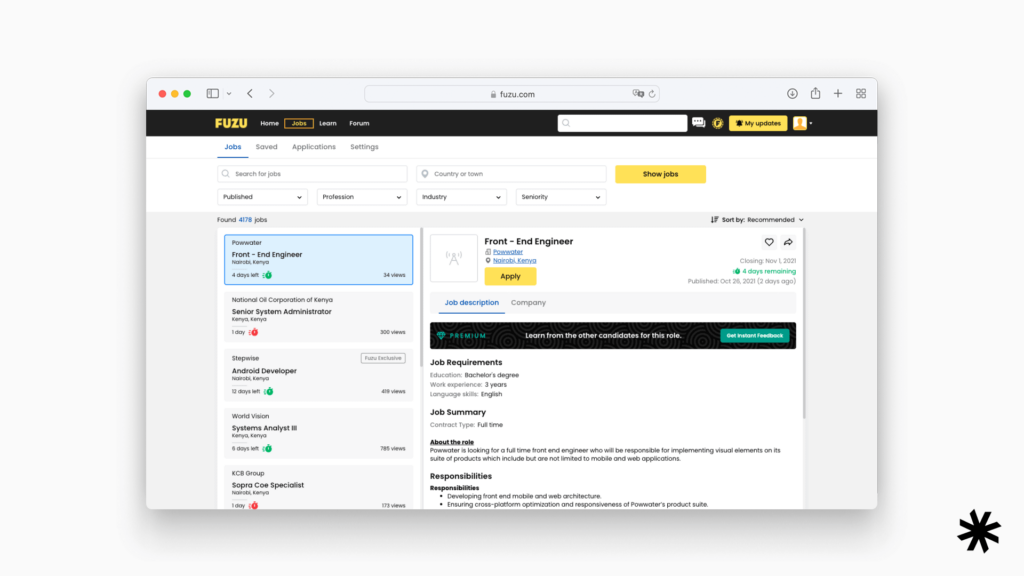
CV builder
Providing the opportunity to create professional, well-structured resumes easily and quickly improves user experience significantly. A common approach is offering tailored templates compatible with application tracking systems (ATS).
Apply for a job
The “Apply for a Job” feature is crucial, allowing job seekers to submit their applications. Typically, job search platforms let applicants choose whether to use the CV created via the platform or attach their own file.
Features for employers
Employer’s profile
Businesses need to provide information about their needs, culture, benefits, and work environment to attract candidates who are a good cultural fit.
They should also be able to review and manage their list of vacancies, add media files, and link to social media.
Moreover, allowing reviews about employers can help build credibility and trust in the platform.The company profile on the job search website Fuzu looks the following way:
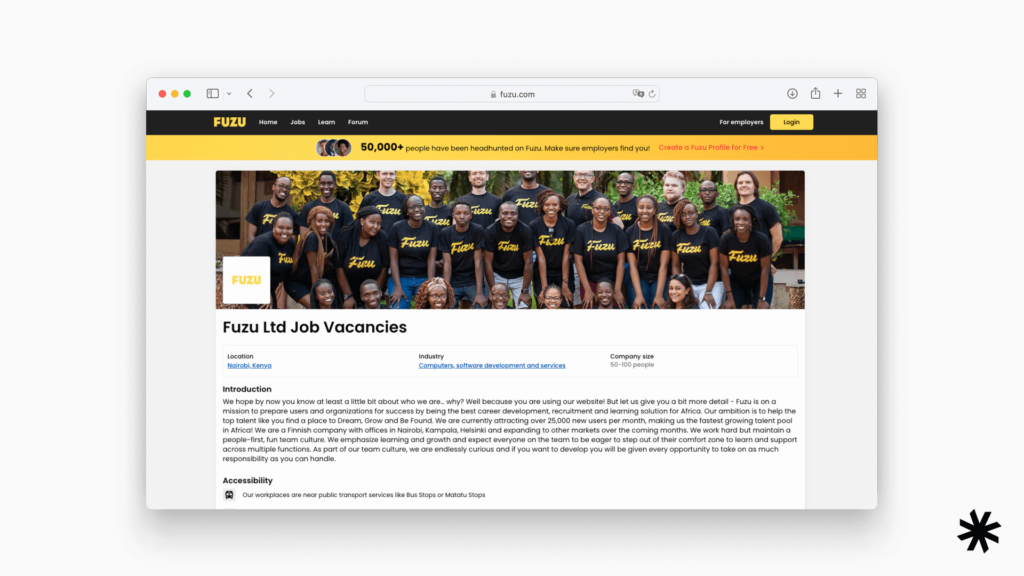
Job posting functionality
Companies should be able to create a job post in seconds. Provide a wizard form where employers can specify key details about the job offering, such as the position name, requirements, responsibilities, and working conditions.
Analytical dashboard
This functionality allows recruiters or HR managers to view statistics related to the job offering, such as views, clicks, and applications. Employers can also make notes about each candidate and set a specific status (e.g., rejected, screened, hired, etc.).
Resume search and filters
Employers can also benefit from an advanced filtering system. By specifying the education level or professional skills of potential employees, they increase their chances of finding the most relevant candidates.
To sum up, the table below highlights the key functionalities for both employers and job seekers that you should consider first:
| Functionality for employers | Functionality for applicants |
| Company profile | Personal profile |
| Analytical dashboard | Employer’s profile |
| Job posting functionality | CV builder |
| Resume search and filters | Search and filters |
7. Consider adding killer features
While core features are essential to ensure the job search website performs its functions and meets the needs of its target audience, they are often not enough to attract users due to competition. To stand out, you need to delight and surprise users in ways your competitors don’t.
Here are some ideas to implement on your job board website to make it different from dozens of similar platforms:
AI-powered job matching
Use artificial intelligence to match job seekers with jobs based on their skills, experience, and preferences. This increases the accuracy and relevance of job recommendations, saving users time and improving match quality.
Video interviewing tools
Provide an integrated video interviewing platform for remote interviews. This streamlines the interview process, saving time and resources for both job seekers and employers.
Job application tracking
Enable job seekers to track the status of their applications and receive updates. This improves transparency, reduces anxiety, and enhances engagement.
For recruiters, this feature helps track the progress of candidates, such as whether they passed screening or provided the required documents.
Skill assessments and certifications
Offer online skill assessments and certifications that job seekers can add to their profiles. This helps job seekers stand out and gives employers confidence in the candidates’ abilities, simplifying the hiring process and building trust in the platform.
CV scraping
This tool saves recruiters time by automatically scanning dozens of CVs to match the skills listed with the requirements of a particular job opening.
When building the job search website Fuzu, we aimed to differentiate it from other market solutions. The standout feature of this project is a machine learning-based system that finds the best-suited candidates for specific job offers.
This significantly simplifies the recruitment process for our customers.
8. Choose a development approach
The choice of the development approach affects the ability to add new features to your platform, scale it, and the amount of effort required to maintain it. Choosing wisely is important, as switching approaches can incur substantial costs.
Let’s take a look at three available options:
Content management systems
Several popular content management systems can help you build a job search website quickly. These include Drupal, Joomla, Magento, and WordPress.
Pros of using a CMS:
- Reduced initial investment: These CMS platforms are open-source and offer a vast array of pre-built plugins and themes, reducing upfront costs;
- Rapid time-to-market thanks to ready-to-use templates and plugins;
- Easy content management thanks to user-friendly interfaces;
- Easy maintenance and troubleshooting thanks to large community support.
Cons of using a CMS:
- Limited customization;
- Potential performance issues in large websites due to limited optimization options;
- Higher security needs: Popular CMS platforms are frequent targets for attacks, requiring robust security measures and updates.
Through our years of providing WordPress development services, we’ve found that a CMS is often the best choice for projects that require a quick launch with essential features and moderate customization needs.
Ready-made software solutions (SaaS)
SaaS job board software like Recooty or Smartjobboard is a popular choice for those wondering how to start a job board within a few days.
Similar to CMS, SaaS platforms require a low upfront investment and offer easy maintenance, as the provider handles troubleshooting, updates, and security.
Other advantages of SaaS:
- Easy scalability that doesn’t require significant investment;
- Fast deployment thanks to minimal setup time.
Disadvantages of SaaS:
- Limited customization and branding;
- Potentially higher long-term costs that result from subscription fees;
- Limited control over data since you rely on the provider for data security and management.
While Syndicode focuses on custom SaaS development, we have experience working with popular ready-made SaaS solutions. These can be an excellent fit for projects with a limited timeline or budget that don’t require extensive customization.
Read also: How to build Software-as-a-Service?
Custom software development
Custom software development involves hiring a dedicated development team that knows how to create a job board from scratch. Custom solutions are tailored to specific business needs, allowing you to decide exactly how the platform looks and works.
Benefits of custom development:
- Full customization: Unique design and functionality tailored to current and projected business needs;
- Perfect scalability and optimization according to precise requirements;
- Enhanced data privacy and protection thanks to full control over data.
Disadvantages of custom development:
- High initial cost;
- Delayed time-to-market: Custom development takes more time, leading to a slower launch compared to other options;
- Maintenance responsibility: Ongoing resource allocation is needed for maintenance and updates.
9. Hire a development team
Depending on the development approach you’ve chosen and your technical skills, you may have to hire software engineers to implement your job search website. A common way to go about it is to outsource specialists from a reliable software development company.
Here’s what you need to look for when choosing a development partner:
Relevant expertise
Experienced software development companies have vast industry knowledge. To be more specific, specialists there know all rules, policies, and main regulations related to a specific domain, in our case, job search websites. So you can be absolutely sure that they know how to build a job board website complaint with them.
If you consider starting a job board website that will operate in countries of the European Union, they should be compliant with GDPR (General Data Processing Regulation). This legal rule protects users’ personal data. To follow this rule, software developers can integrate anti-scrappers. They will prevent other job board websites from copying sensitive information from your platform.
The right technology stack
Another thing that deserves your attention is the technologies used in the software development company. Their choice of technology stack should include mature programming languages, frameworks, libraries, and testing tools. These technologies have already proved themselves. They do not have any bugs or vulnerabilities and have an extensive community.
At Syndicode, we work with the most popular programming languages and frameworks. However, Ruby on Rails is our preferred option for creating a job board website’s backend, thanks to the large number of ready-made solutions called gems that speed up the web development process.
When it comes to front-end technologies, we opt for React.js, Angular.js, and Vue.js. The most beneficial option here is React since it has the best cost/quality/development speed ratio.
Team composition
To start with, the final team composition may vary based on the project’s complexity or timeline. However, it is safe to say that, usually, the software development team needed to create a job board website consists of five specialists, as in:
- A back-end developer
- A front-end developer
- A designer
- A team/technical lead
- A project manager
10. Build iteratively
If you have chosen a custom software development approach, we recommend starting with minimum viable product (MVP) development first.
There are several reasons to launch an MVP of a job search website before building a fully-featured software solution:
- Cost-effectiveness: With an MVP, you can test market demand for your solution without investing too much money. There is no need to build complex functionality. A basic feature set that addresses your target audience’s issues will be enough.
- Fast launch: Creating a software product with limited functionality takes less time, allowing you to release it to the market quickly.
- Valuable feedback: Early feedback allows you to quickly improve your offering.
- Better marketing: You can test your marketing strategies earlier and promote your business more effectively.
When building an MVP of a job search website with Syndicode, you can be sure that the basic functionality will be defined from the start. This way, you can avoid paying extra for rework.
Challenges of building a job board website
Ensuring accurate information
Job search websites manage a vast number of job listings that can change frequently. For instance, positions get filled, job details get updated, or listings get removed.
Besides, many platforms gather listings from multiple sources, including direct employer submissions, aggregated feeds from other job boards, and automated scraping. This increases the chance of duplicates and makes verifying the legitimacy and accuracy of each job listing challenging.
What to do:
- Consider implementing AI and machine learning software to detect anomalies, outdated listings, and duplicates;
- Require employers to verify their identity and company information before posting jobs;
- Vet new employers thoroughly;
- Enable users to report inaccurate or outdated job listings.
User data protection
Job search websites handle sensitive personal information such as contact details, employment history, and possibly financial information. This makes them a prime target for cybercriminals.
Moreover, job platforms often integrate with third-party services (e.g., background checks, and resume parsing), which can introduce additional vulnerabilities.
Job search platforms also have a diverse user base, including job seekers, employers, and recruiters, each with different access needs and behaviors. This poses additional risk coming from internal users who may misuse their access.
What to do:
- Integrate security testing into the development process to ensure your website complies with modern data encryption and safety regulations and uses best practices;
- Ensure your Quality Assurance team implements monitoring tools and intrusion detection systems to detect suspicious activities;
- Maintain post-launch support and maintenance to keep your website protected from the latest threats.
Standing out on the job board website market
While platforms like Indeed, LinkedIn, and Glassdoor, as well as niche job boards, prove that job board websites are popular and in demand, they dominate search results. This makes it difficult for new businesses to attract attention.
Moreover, these giants have significant resources for marketing, development, and customer support. Therefore, a new platform needs to offer more and better features to attract users, which is resource-intensive and poses a high risk of failure.
What to do:
- Focus on a specific industry, job type, or demographic that is underserved by larger platforms;
- Develop unique features or services that address specific pain points of your target audience;
- Concentrate all your efforts on promoting your platform to this specific niche, using the most effective marketing strategies in the industry;
- Stay attentive to your audience’s feedback and continuously innovate and add new features based on their requests.
Matching jobs with candidates relevantly
Job descriptions often use different terminologies for similar roles and may contain vague or non-standard requirements. Similarly, CVs often name the same skills, experiences, and career goals in different ways.
This makes it difficult to create a one-size-fits-all matching algorithm that accurately reflects each candidate’s unique attributes.
Additionally, candidate profiles and job listings may be incomplete, outdated, or inaccurately filled out. Bias in matching algorithms is another factor that can lead to unfair job matches and discrimination.
What to do:
- Implement advanced search and filter options to help users refine search results and improve their relevance;
- Encourage users to use standardized templates to improve the consistency of listings and applications;
- Use skill assessments and certifications to validate candidate skills, leading to more reliable matching criteria and better results;
- Use relevant data to develop AI algorithms to ensure fair and equitable job matching.
How Syndicode can help start a job board website
Syndicode is a software development company with a track record of creating profitable marketplaces. We excel in building innovative solutions from scratch and enhancing, updating, and maintaining existing ones. With our broad expertise, we know firsthand how to build a job search website the right way.
We are committed to our clients’ success and satisfaction, delivering projects on time and meeting expectations. Moreover, we prioritize high-quality performance and usability, ensuring fast loading and responsiveness across platforms.
Our principles were applied to Fuzu, an ambitious project that is now the #1 career platform in Africa.
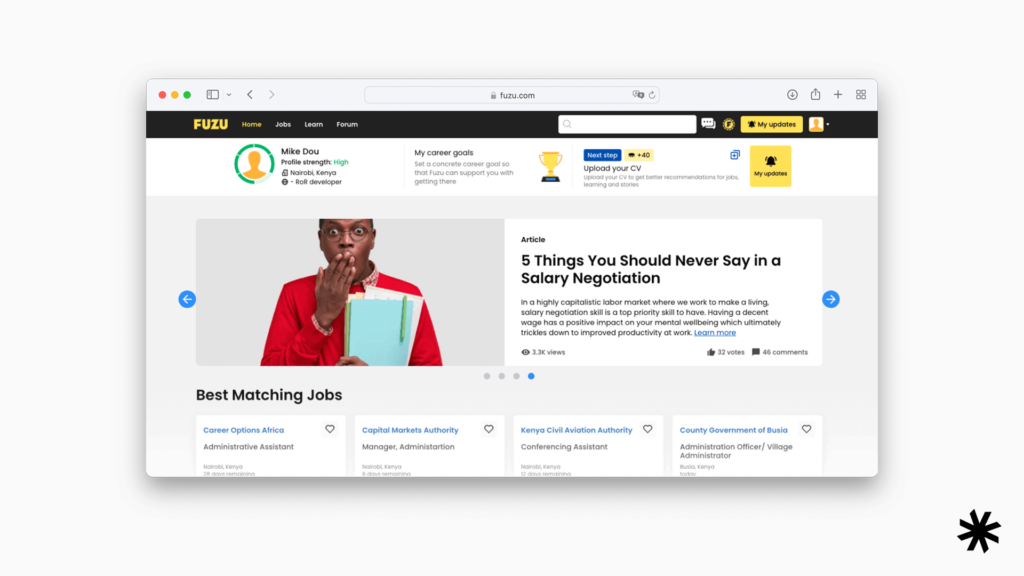
Job posting website Fuzu, built by the Syndicode team
Initially, the customer had a legacy code that was too difficult to maintain. They looked for a tech partner who knew how to build a job search website and could replace the low-tech solution with a modern one.
One of the challenges of this project was a tight timeline. The key question was how to build a job search website within one year. Meeting this requirement would allow the customer to fulfill investor obligations and raise a new round of funding.
We are proud to say that we delivered the project within the specified timeline, enabling the customer to raise a $6.6 million Series A round of financing.
Solution and value delivered
Our team decided to create a job board website from scratch. We made the platform fast-loading and SEO-friendly to help Fuzu rank higher in search results.
In addition, each African country received a separate version, allowing users to view personalized content based on their profile’s specified country.
For user convenience, we created separate portals for applicants and employers. We also built a customizable CV builder with free and paid templates, allowing users to choose background colors, page layouts, and the information they want to display.
Flexible CV builder on the online job board Fuzu
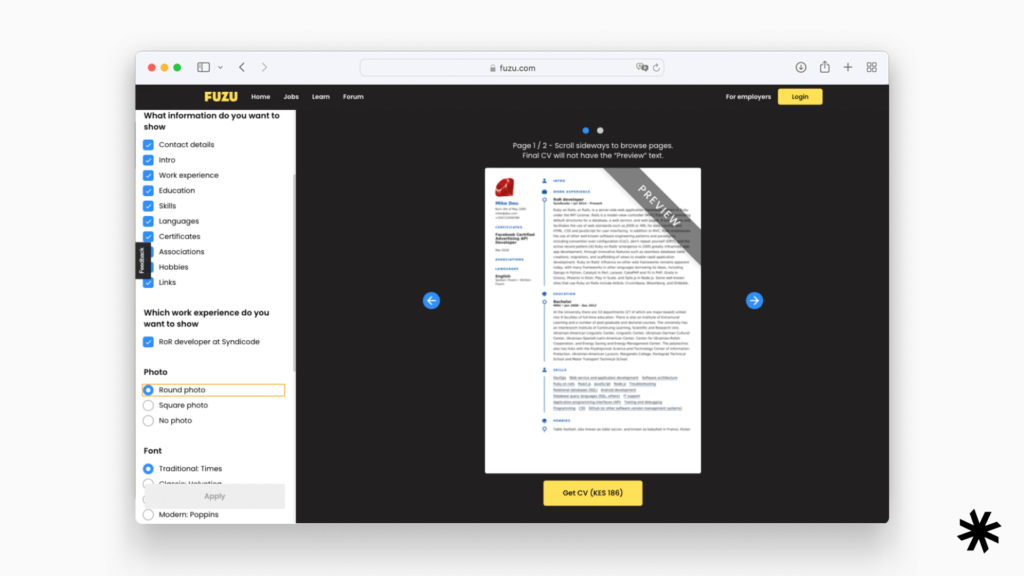
Applicants benefit from a reward system where they earn Fuzu Points, which can be used to purchase Fuzu Premium at a discount. Additionally, various courses help applicants learn new skills to advance their careers.
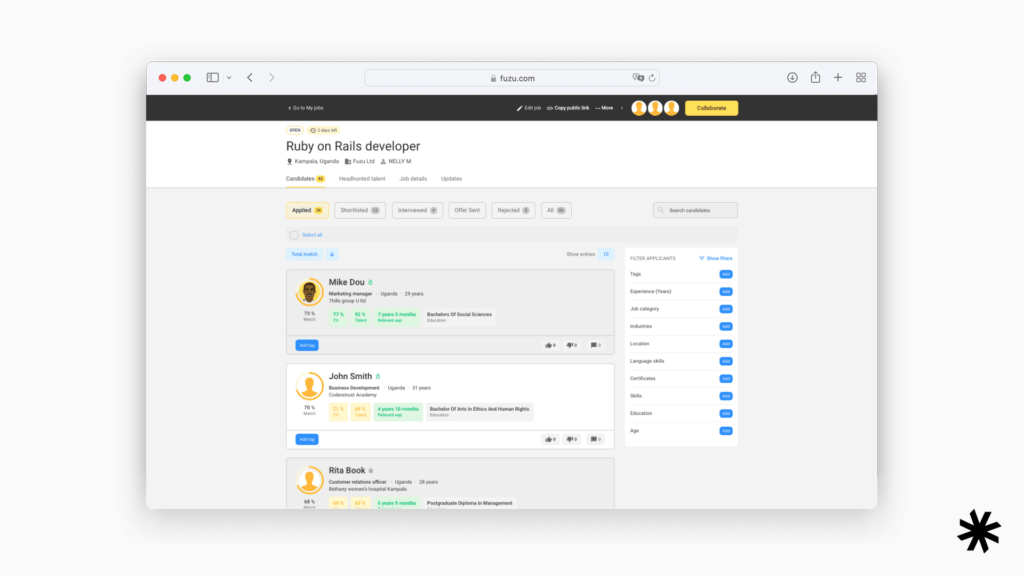
Finally, we applied new UX and UI approaches to create a job board website with user-friendly web and mobile versions, ensuring a seamless experience across devices.
Get a quote for your project
Send us your requirements and expectations, and we will return with an estimate.
Write usCost to create a job search website
Based on our experience, we can say for sure that it takes a minimum of 800 hours to create a job board website with basic functionality. During this time, it’s possible to develop the following features:
- User registration;
- Employer and applicant profile;
- Job listings;
- Search and filters;
- Resume upload;
- Application tracking.
Depending on your development team’s rates, creating such a job board website will cost approximately $200,000–$300,000.
Here’s a rough breakdown of the factors contributing to the cost of building a job search website, along with rough estimates.
| Factor | Components | Time/cost estimate |
|---|---|---|
| Project scope | User registration and profiles; Job listings and search functionality; Resume upload and application tracking | 20–30 weeks |
| Design and UX/UI | Custom responsive design | 2–4 weeks |
| Development team | 1 Project Manager 2 Front-End Developers 2 Back-End Developers 1 UI/UX Designer 1 QA Tester | $45–$70/hour $30–$80/hour $50–$70/hour $20–$60/hour $30–$60/hour |
| Technology stack | Front-End: React Back-End: Ruby on Rails Database: PostgreSQL Hosting: AWS | Setup: $1,000–$5,000 Hosting: $220–$650/month |
| Integrations | Email notifications Social media login | Service costs: starting at $0.15 per 1,000 emails |
| Security | SSL certificate Basic data encryption | $0–$500 per year Starting at $0.03 per 10,000 requests |
| Maintenance and support | 1 QA engineer on demand | $30–$60/hour |
Read also: How much does it cost to build custom software?
Conclusion: How to build a job search website?
The success of your job search website hinges on its ability to seamlessly and efficiently connect job seekers with the right opportunities.
Therefore, creating a job search website involves a multitude of steps and considerations, from defining the core features and choosing the right technology stack to ensuring data security and providing an exceptional user experience.
Maintaining the website post-launch is also crucial. Handling updates, user feedback, and emerging trends ensures the site remains secure, functional, and engaging for users.
But don’t let the complexities of building a job search website hold you back. Contact Syndicode today for professional development help, and let us bring your project to life with precision and expertise.
Frequently asked questions
-
How do job search websites make money?
Several strategies can be used to generate revenue from a job board website. You could charge employers for posting job vacancies or for accessing the CVs of potential candidates. Another option is offering premium features to employers for a fee. Pay-per-click models, where employers pay each time a job seeker clicks on their listing, are also popular. Additionally, subscriptions and sponsored job postings are effective monetization methods for a typical platform.
-
What are the steps for building a successful job search website?
If you wonder how to build a job search website, start by choosing your niche. Decide whether you want to create a general or niche-specific platform and whether it should cater to a local or international audience. Then, select a revenue model. Consider various revenue streams such as subscriptions, premium features, pay-per-click, and sponsored job posts. Your next step is to define functionality. Outline the features and services you will offer to both employers and job seekers. After that, think about innovative features that will set your platform apart from competitors. Proceed by partnering with a software development company and begin implementing your idea with an MVP to test your business concept. Based on initial feedback, you can then expand to a full-scale website and launch it to the public.
-
Why choose Syndicode for job board development?
Choosing Syndicode for job board development offers numerous advantages. Firstly, our extensive experience in building such platforms ensures they are built to succeed, with all our projects achieving break-even within the first year and therefore providing stable revenue for their owners. Secondly, as a full-cycle development company, we support our clients through every phase of product development, from initial idea validation to post-launch maintenance. Lastly, our team comprises only the most talented and skilled professionals, guaranteeing the highest quality service. With Syndicode, you can be confident that your project is in expert hands.
-
What are the essential features of a job search platform?
A job search website must perform the following functions: allow job seekers and employers to create and manage accounts, enable job postings and search, facilitate resume submission and allow users to track their application status, provide email or SMS notifications for new job postings and application updates, match job seekers with relevant job openings, and allow job seekers to review employers and vice versa. In addition, it must protect user personal data and be easy to use across devices. Therefore, the core features of a job search website include user registration and profiles, job listings and search, resume upload and application tracking, job alerts and notifications, AI-powered matching algorithms, user reviews and ratings, security features, and mobile optimization.
-
How can I attract job seekers and employers to my website?
Attracting job seekers and employers to your job search website requires a strategic approach. Focus on marketing, user experience, and your value proposition. Partner with reputable companies to ensure a wide range of attractive job listings. Optimize your website for search engines. Consider creating valuable content such as blog posts, guides, and webinars to build credibility and trust. Employers will come where candidates spend the most time. To speed up this process, you can use targeted ads to reach potential employers in specific industries or regions. In addition, offer flexible pricing plans and packages tailored to different business sizes and needs.
-
How to grow a job board website?
The first step to scaling your job search website is to ensure it provides a good user experience for a larger number of users. Optimize your website for use across devices and ensure fast loading times. Consider adding advanced features such as improved matching algorithms, better analytics, and a notification system. Finally, boost your marketing by expanding to more channels and building industry partnerships.
